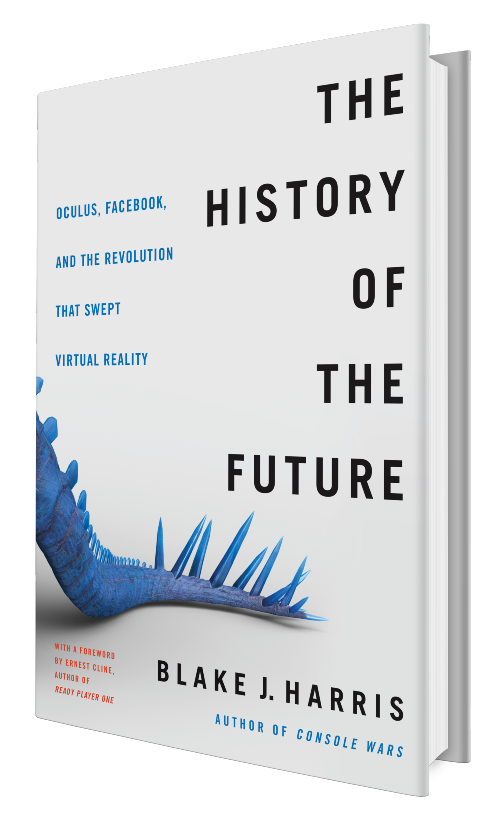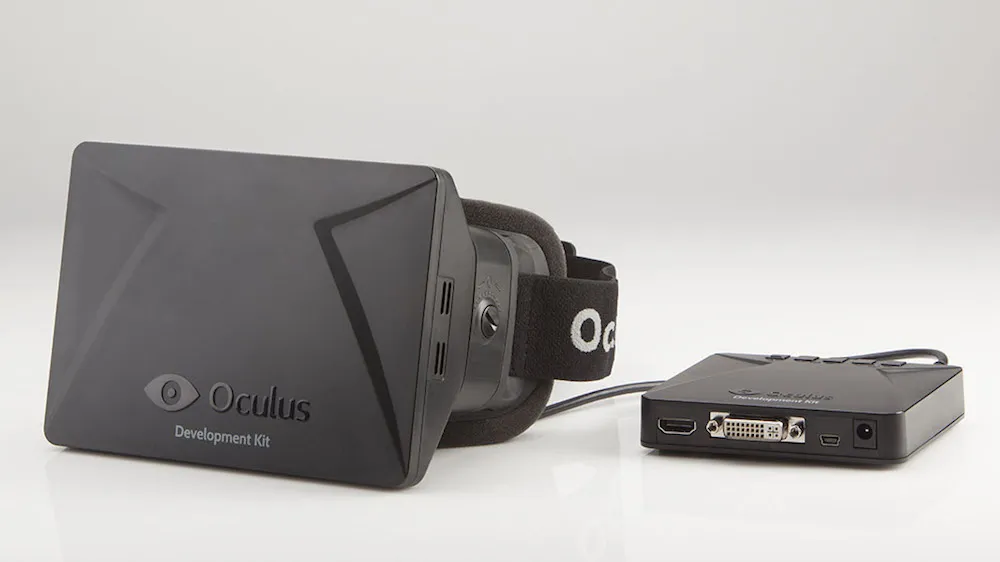The new book The History Of The Future is out today in hardcover, ebook and audiobook. The narrative written by Console Wars author Blake Harris charts the 2012 founding of Oculus. Along the way there is an accounting of the $3 billion acquisition by Facebook and $500 million jury decision. The story ends after the 2017 exit of Oculus co-founder Palmer Luckey.
Along the way is Chapter 23, titled NINE STORIES. The chapter focuses on developers in April 2013 receiving the first Rift development kit — known as DK1. 56,334 of the headsets would eventually ship out to 114 countries. The nine stories provide an intimate look into how some lives changed with the arrival of that VR headset.
Last week, we published a remarkable email referenced in the book originally sent by John Carmack in 2015 to Oculus leaders. The document assesses the group’s strengths and weaknesses with extraordinary detail. This week, we are printing excerpts from Chapter 23.
Below are the first four of the nine stories. Check back tomorrow when we excerpt the remaining five stories from Chapter 23 of The History Of The Future.
FOUR STORIES
April 2013
“Check this out,” Luckey said, showing Dycus an eBay web page littered with results.
Skimming the items, Dycus couldn’t help but grin: Oculus’s $300 devkits were in such high demand that some were going for over a thousand bucks.
By this point, the first week of April, it was now clear that the launch of DK1 had been an unmitigated success. Secondhand units were selling for three times their price; tech journalists were publishing glowing reviews; and Luckey’s in-box was flooded with affection and admiration—comments like this one, from a Korean fan, proclaiming that Luckey was “going to be a historic human in 21c.” But as cool as all that was, none of it compared to the fact that developers all over the world were starting to receive their devkits in the mail; and over the next few months, these devs would get to work and begin building incredible things . . .
1. JUSTIN MORAVETZ
Santa Monica, California
In seventh grade, Justin Moravetz and his classmates were asked to give a presentation about “The Future.” So Moravetz decided to talk about the technology that excited him most—virtual reality!—and even cobbled together a makeshift headset using a VGA monitor and two Game Boy Screen Magnifiers. For the next two decades, he waited for VR to finally arrive in all that glory he had imagined as a boy. But year after year yielded disappointment after disappointment.
From Forte’s VFX1 to eMagin’s latest Z800 3-DVisor, Justin Moravetz had seen it all. From his experience as a 3-D animator at Sony Computer Entertainment, Moravetz had insight into what a powerhouse was doing with virtual reality. And, well, it wasn’t much. He came to believe that the only way virtual reality could ever really take of would be for a small, scrappy outside force to come in—resurrect the technology from the ashes of its failures—and force big companies (like the one he worked for) to jump into the fray.
Would this ever happen? Moravetz did not know. But he felt hope—glorious, long-lost hope—as he tore open the package containing his devkit and read the welcome letter inside.
Unlike almost every other developer, Moravetz had already come up with an idea. In fact, using Unity, he had already spent the past six months creating various levels for a retro-inspired, Arkanoid-style brick-breaking game he called Proton Pulse.
It was challenging to make an Oculus-ready game without an actual Oculus headset, but Moravetz’s lifelong passion for VR coupled with his animation expertise gave him the ability to develop something that he thought would be viable.
Now, after six months’ worth of nights and weekends spent developing this game, he was about to find out how viable it would really be.
2. DENNY UNGER
Qualicum Beach, Canada
Within moments of putting on DK1 for the first time, Denny Unger started crying. He couldn’t help it. Ever since trying a Virtuality VR system at Edmonton’s Klondike Days expo in 1992, he had been infatuated with virtual reality. It wasn’t that the Virtuality demo had been especially good (he left the demo sick to his stomach) but because, he assumed, that if VR hardware progressed on the same trajectory as, say, video game consoles, then it would only be a few years until virtual reality started to take of.
That, of course, didn’t happen. But eventually, Unger found solace in a community of fellow VR diehards called MTBS3D. It was there he met Palmer Luckey who—as Unger would fondly recall years later—“had kind of cracked the code of how we could do this affordably using current technology.” So when Luckey announced that he was planning to sell an open-source HMD kit on Kickstarter, Unger was so excited that he volunteered to design the logo for this little venture called “Oculus.”
At the time, Unger had no expectation that VR would become interesting to anyone outside the hundred or so hobbyists who frequented the forums on MTBS3D. But his perspective began to change after John Carmack wound up demoing Luckey’s prototype later that year at E3. Oh shit, Unger thought. There’s a big opportunity here that no one understands yet! In late 2012, Unger quit his job (designing tabletop games) and recruited a few tech-savvy friends (Christopher Roe, Matthew Lyon, Paul White, Dan Taylor and Joel Green) to start a studio (Cloudhead Games) focused on creating “deeply immersive” gaming experiences.
“We’ve got this golden opportunity to really do something special,” Unger told the team during one of their early meetings in his garage-turned-game-studio. What he had in mind was a game that combined the adventurous spirit of films like The Goonies and Indiana Jones with the hidden challenges and mystery-island feel of his all-time favorite
puzzle game: Myst. To help finance this built-for-VR puzzle/adventure game—The Gallery: Six Elements, they called it—the Cloudhead Games team launched a Kickstarter campaign in late March 2013. And that campaign had all but hit its goal by the time Denny Unger received his devkit in the mail.
There was a lot riding on the Tuscany demo he was about to try. Which is why, within moments of putting on DK1 for the first time, Denny Unger started crying. Tears of joy—of pure, unadulterated, dream-come-true joy. Because this moment felt like every Christmas ever; because even though he knew he was still in Canada, he felt like he was all the way in Italy; because if this was just first-generation hardware, could you imagine what the future would bring? It was all so wonderful and overwhelming. But before allowing himself to fully imagine those possibilities—for himself, for Cloudhead Games, for the future of human interaction—Unger had the urge to email an old friend. “Thanks for bringing us the future,” he wrote.
3. OWLCHEMY LABS
Boston, MA
“I think that this is the beginning of a forty-year-industry,” Devin Reimer, the CTO of Owlchemy Labs, told Owlchemy founder and CEO Alex Schwartz. This was months earlier, right after Oculus’s Kickstarter had launched. Reimer—being a big fan of John Carmack—had been following the lead-up to the launch, and somewhere between E3 and QuakeCon, he had become convinced that VR was about to upend the gaming industry. “I think that this is the beginning of a forty-year-industry. And I think we should do something here.”
At the time, Schwartz didn’t know much about VR—Owlchemy’s focus, after all, was mobile gaming—but he trusted Reimer’s instinct and agreed they should order a devkit. Then the two of them got back to work and didn’t discuss VR again until a devkit showed up at their office.
Intrigued by the headset and impressed with Oculus’s SDK, Schwartz and Reimer decided to take of a month from their current obligations and create a VR version of a base-jumping game they had published in 2011 called AaaaaAAaaaAAAaaAAAAaAAAAA!!! For The Awesome.
Since Aaaaa!!! had originally been built using Unity, it only took two days to get their port working. But then it took the rest of the month to get it working in a way that was fun and functional and could be played end to end without taking of the headset.
During this time, the Owlchemy team learned many things. Things like: the camera angle is sacred, controllers (not keyboards) are essential, and motion sickness—believe it or not—is addressable. Though perhaps the biggest lesson they learned was that if you tell anyone—friends, family members, fellow developers; anyone—that you’re thinking about “betting the future of the company on VR,” every single one of them will inevitably say the same thing: YOU’RE CRAZY.
4. CCP
Reykjavík, Iceland
“I know it’s a bit crazy . . .” wrote Sigurður “Siggi” Gunnarsson, a senior web developer at CCP Games, in a late 2012 company-wide email that he hoped might lead to the creation of a VR team. It didn’t need to be a big team—even just a few would signify a great start. “I know it’s a bit crazy to spend your free time doing something you spend your working hours on, but the goal here is not to create a commercial success, but to have fun, learn new things, and try out new ideas.”
Shortly after this call to arms, a small crew of collaborators came together. In addition to Gunnarsson, there was graphic artist Andrew Robinson, software engineer David Gundry, and a pair of QA (quality assurance) analysts: Ian Shiels and Louisa Clarke. On paper and in person, this small skunkworks team had little in common. Except for two things: they all had relatively low-level roles working on CCP’s hit space adventure MMORPG EVE Online; and they all had been fascinated by VR for many, many years.
“For me, it started in college,” Gunnarsson recounted to the team over beers, as they met at a local bar to discuss potential game ideas. “Games like D&D and Shadowrun. I was always just imagining how would it be if you could make a computer game in the future where you and your friends could go into VR and just go somewhere else and work together as a group.”
The crew really liked that idea—of group play; of something social; of creating a VR game that thrust multiple people into the same shared experience. But what should that experience be? A roller-coaster ride? A rocket race through space? Maybe a wormhole battle? Wait, what the hell was a wormhole battle?
Andrew Robinson took notes on a bar napkin and drew little sketches of these ideas. Just scribbling, just screwing around, until Louisa Clarke threw out a concept that sounded like a game that they all suddenly very much wanted to play.






























